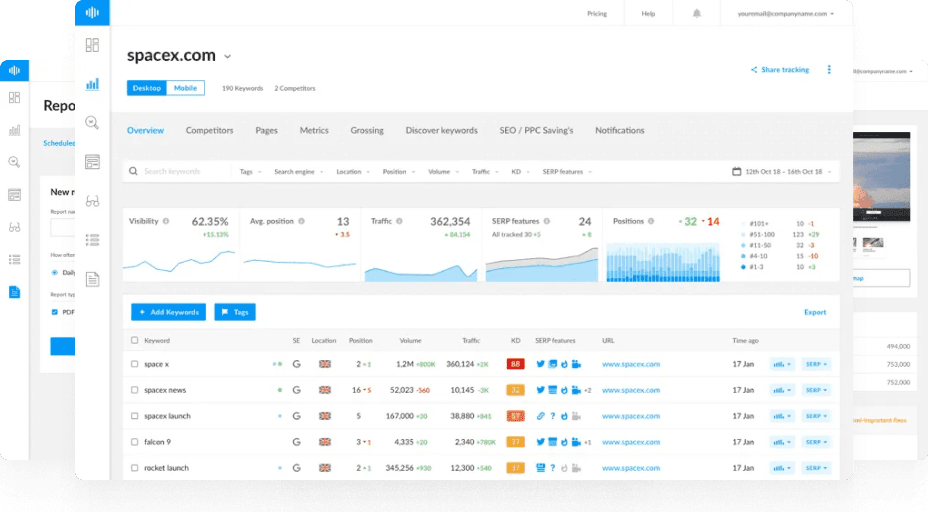What is Vector SEO?
Vector SEO (or Embedding Optimization) is the practice of optimizing web content so that semantic search engines and AI models — which use vector embeddings to represent meaning — can accurately understand, retrieve, and rank it.
Instead of matching keywords exactly, vector-based systems (like Google’s MUM, Gemini, and OpenAI’s GPT) interpret semantic similarity — understanding the intent, context, and meaning behind words.
In this new search paradigm, success depends less on keyword repetition and more on semantic relationships, entity context, and content quality that resonates within the AI’s embedding space.
What Are Embeddings?
An embedding is a numerical representation of text meaning.
Each word, phrase, or paragraph is converted into a vector — a list of numbers that capture its semantic relationships.
For example:
The words “SEO strategy” and “search engine optimization plan” might have embeddings that are very close in distance, meaning the AI understands they convey similar ideas.
Embedding models (like Google’s text-embedding API or OpenAI’s Ada-002) create these representations, allowing AI systems to compare concepts mathematically — not just linguistically.
Why Vector SEO Matters
Modern search and AI systems rely on semantic retrieval rather than traditional keyword matching.
This shift means that ranking, retrieval, and discoverability depend on how well your content is positioned in vector space.
1. Semantic Search Is the Future
Search engines and LLMs retrieve results based on meaning and relevance, not just term frequency.
2. AI Overviews and Generative Results
Features like Google’s AI Overviews use embeddings to cluster and summarize semantically related content — determining which pages are contextually relevant.
3. Cross-Language Understanding
Embeddings allow multilingual models to understand your content’s meaning across languages, improving visibility in international SEO.
4. Personalized Search Experiences
Vectorized data supports personalization by matching user profiles, history, and preferences to semantically relevant content.
How to Optimize for Vector SEO
1. Write Semantically Complete Content
Cover topics in depth. LLMs and embedding systems favor content that fully explains relationships between ideas. Include definitions, context, use cases, and examples.
2. Target Search Intent, Not Just Keywords
Focus on what users want to know rather than how they phrase it.
Example: Instead of optimizing for “AI SEO tools,” write content that also addresses “AI content optimization,” “machine learning for SEO,” and related intents.
3. Use Entity-Based Structure
Define key entities and their relationships using schema markup. This helps search engines and AI systems place your content in the correct semantic cluster.
4. Build Thematic Consistency
Create topic clusters — groups of related articles that reinforce each other semantically.
Google’s embedding models reward consistent, interconnected context across your site.
5. Leverage Synonyms and Contextual Variations
Use natural, varied language that mirrors human communication. Embedding models recognize related phrasing, so diverse expressions can improve reach.
6. Optimize Metadata for Meaning
Your titles, descriptions, and headings should reflect conceptual relationships rather than exact keywords. For instance:
“How Generative AI Changes SEO” performs better semantically than “AI SEO Tips.”
7. Publish Structured and Text-Based Content
Ensure your content is in clean HTML, not locked in images or PDFs. AI crawlers need access to textual data to generate embeddings accurately.
8. Track AI and Semantic Visibility
Use Ranktracker’s SERP Checker and Web Audit to monitor your site’s performance in AI-augmented SERPs and structured data coverage.
Vector SEO vs Traditional SEO
| Feature | Traditional SEO | Vector SEO |
|---|---|---|
| Focus | Keywords & backlinks | Semantic meaning & relationships |
| Ranking Basis | Keyword frequency | Contextual similarity in vector space |
| Optimization Goal | Rank for phrases | Appear in AI summaries & semantic clusters |
| Measurement | CTR, rankings | Contextual relevance, embeddings proximity |
| Search Type | Rule-based retrieval | Neural semantic retrieval |
Example of Vector SEO in Action
A search for “best tools for SEO insights” may retrieve:
- “AI-driven keyword analysis tools”
- “SERP visibility platforms”
- “Rank tracking software for agencies”
Even though none contain the exact phrase, embeddings tell the system they’re semantically equivalent, so they rank or appear in AI Overviews.
Technical Notes for Developers
To improve embedding compatibility:
- Avoid keyword stuffing. It weakens semantic coherence.
- Keep consistent context throughout a page (avoid topic shifts).
- Use structured data (
Article,Organization,Product). - Provide definitions of entities (LLMs use these for vector anchoring).
- Leverage canonical URLs to help retrieval systems reference your content correctly.
Tools Supporting Vector SEO
- Ranktracker Keyword Finder: Identify semantically connected terms.
- Web Audit Tool: Validate structure, schema, and crawl accessibility.
- SERP Checker: Monitor AI-influenced ranking and clustering.
- AI Article Writer: Generate semantically coherent, entity-rich content for vector indexing.
The Future of Vector SEO
Vector SEO is foundational to the next era of AI-driven search.
As embeddings become the universal language of meaning across models, success will rely on semantic completeness, entity precision, and machine readability.
Expect to see:
- Embedding optimization tools integrated into SEO platforms.
- Cross-model tracking for LLM citation frequency.
- AI-native ranking metrics measuring semantic relevance.
Summary
Vector SEO aligns your content with how AI understands meaning — through embeddings and relationships, not keywords.
By focusing on context, clarity, and entity structure, you make your website discoverable and citable in the semantic web that underpins Google’s AI Overviews, Bing Copilot, and future generative systems.
